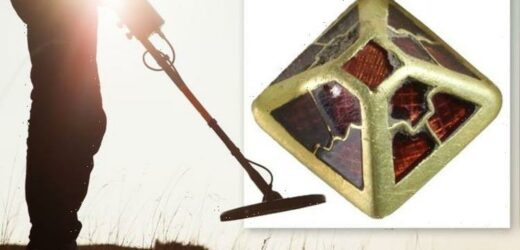Essex: Archaeologists discover Anglo-Saxon tomb in Prittlewell
We use your sign-up to provide content in ways you’ve consented to and to improve our understanding of you. This may include adverts from us and 3rd parties based on our understanding. You can unsubscribe at any time. More info
The ornament was uncovered in the Breckland area of Norfolk last April. Archaeologists have since dated it to the Sutton Hoo era between 560 and 630 AD. At the time, Norfolk was part of the Kingdom of East Anglia, which thrived until its incorporation into the Kingdom of England in 918.
The object is a pyramid-shaped sword ornament exquisitely crafted gold and garnet.
Ornaments like these would have been part of the straps and bands securing a sword to its scabbard.
The luxurious nature of the object suggests it belonged to an Anglo-Saxon lord and was possibly lost while “careening around the countryside” on horse.
According to finds liaison officer Dr Helen Geake at the Portable Antiquities Scheme, the red garnets encased in the gold would have come from Sri Lanka or India.


The discovery hints at the lucrative trade that was going on between the British Isles and the far East more than 1,000 years ago.
Ornaments like these would have come in pairs, so Dr Geake likened its loss to the “very annoying” loss on one earring.
She said: “It would have been owned by somebody in the entourage of a great lord or Anglo-Saxon king, and he would have been a lord or thegn who might have found his way into the history books.
“They or their lord had access to gold and garnets and to high craftsmanship.”
Thegns were medieval noblemen who in the Anglo-Saxon period were given land from the king in return for military service.

The ornament was handed over to the Norfolk Coroner’s Office, as required by the law.
The Government advises: “There is a legal obligation to report archaeological finds found in England, Wales or Northern Ireland that qualify as Treasure.”
This legal obligation has been in place since 1926.
A similar pair of sworn ornaments were uncovered at the famous ship burial at Sutton Hoo near Woodbridge in Suffolk.
According to Dr Greake, the ornaments are less commonly found in the ground likey as a result of accidental losses.


She added: “Lords would have been careening about the countryside on their horses and they’d lose them.”
Sutton Hoo is the site of two early medieval cemeteries dating to the sixth and seventh centuries.
Archaeologists have been exploring the site since 1983, uncovering a wealth of Anglo-Saxon treasures and history.
One of the most famous discoveries at the site is an ornate helmet found in 1939.
Archaeologists believe the helmet has a link to the King Raedwald of East Anglia and was buried sometime around 625 AD.
Today, the Anglo-Saxon burial site covers a 225-acre estate and according to the National Trust, is “home to one of the greatest archaeological discoveries of all time”.
The discoveries at Sutton Hoo have been at the heart of the Netflix film, The Dig starring Carey Mulligan and Ralph Fiennes.
The National Trust said: “Despite the large number of archaeological campaigns undertaken at Sutton Hoo there are still undoubtedly secrets hidden in the soil.
“Several areas of the Royal Burial Ground have not been excavated.”
Source: Read Full Article

